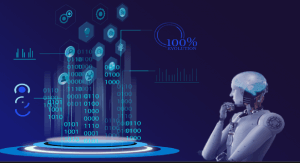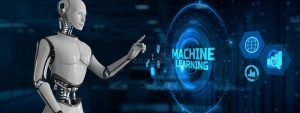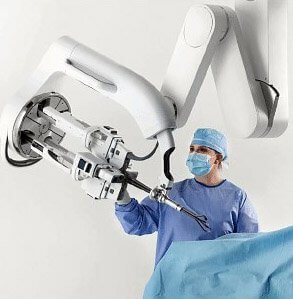Artificial Intelligence and Machine Learning- Club
Exploring Artificial Intelligence and Machine Learning at SLRTCE
 Artificial Intelligence consists of many subfields that use techniques to mimic specific behaviors we associate with natural human intelligence. For example, humans can speak, hear, read and write language and glean meaning from it. The fields of speech recognition and natural language processing mimic these abilities by converting audio signals into text and processing that text to extract meaning from it. Other subfields are building artificial systems that replicate human behaviors like our ability to move through our physical environment (robotics), see and process visual information (computer vision), and identify and categorize objects (pattern recognition).AI algorithms have a variety of uses in the world today with countless research projects exploring new ones all the time.
Artificial Intelligence consists of many subfields that use techniques to mimic specific behaviors we associate with natural human intelligence. For example, humans can speak, hear, read and write language and glean meaning from it. The fields of speech recognition and natural language processing mimic these abilities by converting audio signals into text and processing that text to extract meaning from it. Other subfields are building artificial systems that replicate human behaviors like our ability to move through our physical environment (robotics), see and process visual information (computer vision), and identify and categorize objects (pattern recognition).AI algorithms have a variety of uses in the world today with countless research projects exploring new ones all the time.
What is weak Artificial Intelligence?
Weak AI, also called narrow AI, is used to produce human-like responses to inputs by relying on programming algorithms. Weak AI tools are not actually doing any “thinking,” they just seem like they are. Voice-activated personal assistants like Siri, Cortana and Alexa are common examples of weak AI. When you ask them a question or give them a command, they listen for sound cues in your speech, then follow a series of programmed steps to produce the appropriate response. They have no real understanding of the words you speak or the meaning behind them.
What is strong Artificial Intelligence?
Strong AI, or “true AI,” refers to any system that can think on its own. These AI systems can reason, learn, plan, communicate, make judgments and have some level of self-awareness. In essence, they don’t simulate the human mind, they are minds, at least in theory. If we can replicate the architecture and function of the human brain, experts believe we can build machines with genuine cognitive ability. In the AI field of deep learning, scientists are using neural networks to teach computers to be more autonomous, but we’re still far from the types of independent AI depicted in science fiction. While change is coming rapidly, at this point, truly strong AI is still closer to a philosophy than a reality.
Machine learning
 Machine learning is the field of computer science working to develop computer systems that can autonomously learn from experience — specifically, by processing the data they receive — and improve the performance of specific tasks. The term “machine learning” is often used interchangeably with the term “artificial intelligence,” but machine learning is a subfield of AI.
Machine learning is the field of computer science working to develop computer systems that can autonomously learn from experience — specifically, by processing the data they receive — and improve the performance of specific tasks. The term “machine learning” is often used interchangeably with the term “artificial intelligence,” but machine learning is a subfield of AI.
In Supervised machine learning, a data scientist guides an AI algorithm through the learning process. The scientist provides the algorithm with training data that includes examples as well as specific target outcomes for each example. The scientist then decides which variables should be analyzed and provides feedback on the accuracy of the computer’s predictions. After sufficient training (or supervision), the computer is able to use the training data to predict the outcome of new data it receives.
 In Unsupervised machine learning, algorithms are provided with training data, but don’t have known outcomes to use for comparison. Instead, they analyze data to identify previously unknown patterns. Unsupervised learning algorithms can cluster similar data together, detect anomalies within a data set and find patterns that correlate various data points.
In Unsupervised machine learning, algorithms are provided with training data, but don’t have known outcomes to use for comparison. Instead, they analyze data to identify previously unknown patterns. Unsupervised learning algorithms can cluster similar data together, detect anomalies within a data set and find patterns that correlate various data points.
Semi-supervised machine learning algorithms, as the name suggests, combine both labeled and unlabeled training data. The use of a small amount of labeled training data significantly improves prediction accuracy while mitigating the time and cost of labeling huge amounts of data.
What is Artificial Intelligence and Machine Learning specialization in Engineering?
Artificial Intelligence and Machine Learning is a branch of study or discipline which includes theories, standards, methods and innovations of various different domains like mathematics, cognitive science, electronics and embedded systems to make intelligent systems that mimic human behavior. Artificial Intelligence (AI) and Machine Learning (ML) focus on collecting, categorizing, strategizing, analyzing and interpreting data. It is a specialized branch that deals with the development of embedded systems like robotics and IOT based applications. It also incorporates the concepts of machine learning and deep learning model building for solving various computational and real-world business problems.
Role of AI in Healthcare
From chronic diseases, like cancer, to radiology, AI is being leveraged to deploy efficient and precise inventions that will help take care of patients suffering from these diseases and hopefully find a cure for them. AI provides several advantages over traditional methods of analytics and making clinical decisions. AI algorithms make the systems more precise as they get the opportunity to understand training data, which furthers helps humans get unprecedented insights into treatment variability, care processes, diagnostics, and patient results.
Virtual Health Assistants
Virtual health assistants are responsible for a number of things, including responding to the queries of routine patients via calls and emails, managing medical information of the patients and covering sensitive data, scheduling appointments with doctors, sending follow-ups and clinical appointment reminders to the patients, etc. This is created by integrating systems with cognitive computing, augmented reality, and body and speech gestures. It is among the most useful AI applications in healthcare that offers a personalized experience to patients in terms of managing their health and getting rid of their queries. It reduces the frequency of visits to the hospitals, benefitting both patients and healthcare experts.
Automation of Redundant Healthcare Tasks
 Another significant role of Artificial Intelligence and its tools in healthcare is that it automates redundant, time-consuming tasks. This leads administrators to have some spare time and go on working with other important and necessary tasks. Olive is an AI-based platform that automates several processes such as checking the eligibility of un-adjudicated medical claims, transferring the necessary medical data to the respective medical professionals, and so on. Olive integrates with the existing tools and software of a hospital easily, eradicating the requirement for expensive downtimes and integrations.
Another significant role of Artificial Intelligence and its tools in healthcare is that it automates redundant, time-consuming tasks. This leads administrators to have some spare time and go on working with other important and necessary tasks. Olive is an AI-based platform that automates several processes such as checking the eligibility of un-adjudicated medical claims, transferring the necessary medical data to the respective medical professionals, and so on. Olive integrates with the existing tools and software of a hospital easily, eradicating the requirement for expensive downtimes and integrations.
Robot-assisted Surgery
Robot-assisted surgery has gained a lot of popularity recently. Several hospitals are implementing robotics that assists them in completing tasks that require precision, control, and flexibility. It is used in tasks, including open-heart surgery, exceeding human capabilities. Robots integrated with mechanical arms, cameras, and required surgical instruments augment the knowledge, skills, and experience of the doctors, creating a new form of surgery. This allows surgeons to sit at the console of a computer and control the robot’s mechanical arms, while the robot offers a magnified, 3-dimensional view of the surgical site that is impossible to look at with their own eyes. Surgeries that are assisted by AI-implemented robots result in lesser complications, comparatively lesser pain for the patients, and a faster recovery rate.
Automated Image Diagnosis
AI applications make it easy to decipher images to conduct analysis. Using Deep Learning technologies and programs, these AI systems equip themselves with algorithms that offer a quicker reading of complex images, including those from CT scans and MRIs. The automated image diagnosis system offers improved performance to doctors, providing better diagnoses of diseases. Moreover, it is a vital tool when it comes to combating the shortage of radiologists and other medical professionals in hospitals. AI has made tremendous progress in medical imaging in the past years.
Fraud Detection
While there are several patients searching for effective medical services that save cost, there is also an exponential rise in the rate of fraud cases. This has made most medical organizations and patients suffer huge damage. With the help of AI-based solutions, these fraud attempts have reduced massively as these tools allow elaborate navigation through the processes and detect fraud.
Clinical Trial Participation
In clinical trials, a large amount of data needs to be collected and organized to get the right theory for a particular disease and its treatment. With the help of AI applications, hospitals become capable of facilitating a result-driven approach to the respective clinical trials. For these trials, AI allows neural networks to predict the bioactivity and characteristics of each patient.AI platforms have assisted researchers to find the right candidates to test developmental drugs for various diseases and disorders. It is indispensable in these cases to select the right candidates, and due to AI, the healthcare industry has witnessed a statistical rise in the success of clinical trials with increased speed and lesser investment.

